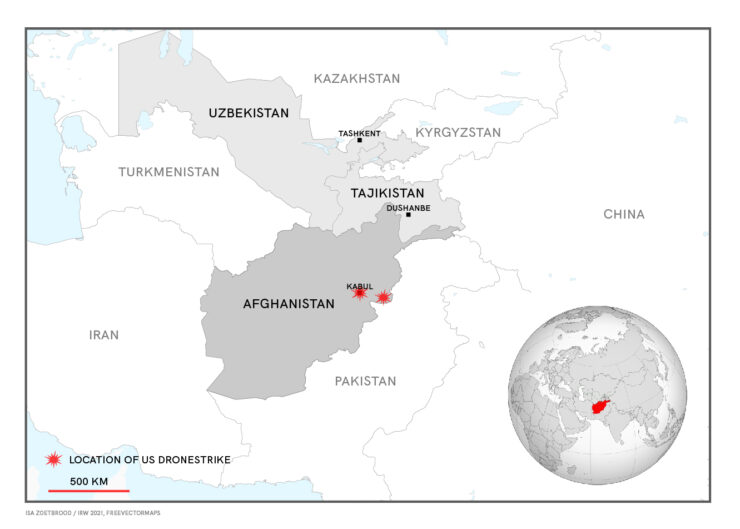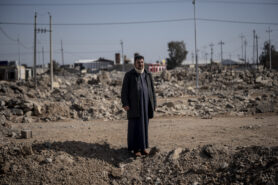The world watched as chaos erupted in the final weeks of the US deployment in Afghanistan. Cities fell to the Taliban. Desperate people flocked to Hamid Karzai International Airport in Kabul in hopes of evacuation. And amongst the commotion there was the terrorist attack by the Islamic State in Khorasan Province (known as ISKP) which took the lives of 170 Afghan people and 13 US service members on the 26th of August.
The US pull-out from Afghanistan had been announced on the 14th of April 2021 by President Joe Biden. During his speech, President Biden contended that the US pullout from Afghanistan marked the end to the “forever war”. However, the speech also described how US forces would “reorganise… counterterrorism capabilities in the region”. In a previous IRW round-up, we discussed how the U.S withdrawal from Afghanistan can be considered less of an end to their engagement in the region and more of a shift in military tactics, from removing the last remaining “boots on the ground” towards a war fought solely from a remote distance.
Proof that the US are not ending their engagement in Afghanistan can be witnessed in their pursuit of basing rights in neighbouring countries Tajikistan and Uzbekistan. The US currently are operating an airbase in Al Udeid, Qatar, however, the distance from Qatar to Afghanistan is costly, with aerial refuelling meaning that US pilots have little airtime over Afghanistan. The acquisition of military bases where surveillance and drone operations could still operate over Afghan airspace will greatly facilitate US continued efforts to maintain a presence in Afghanistan.
On the 31st of August 2021, US Secretary of State Blinken confirmed:
“We will remain vigilant in monitoring threats ourselves and will maintain robust counterterrorism capabilities in the region to neutralize those threats if necessary, as we demonstrated in the past few days by striking ISIS facilitators and imminent threats in Afghanistan – and as we do in places around the world where we do not have any military forces on the ground”.
Forging political alliances, building military base sharing facilities and relying on remote technologies, such as drones, are not new military strategies (see Demmers & Gould 2018). Drones, for instance, have been deployed since the inception of the US war on Afghanistan and in many theatres of war since, including Pakistan, Yemen, Somalia, Syria and Iraq. However, the shift to ever more remoteness in Afghanistan and elsewhere – from the removal of Western military bodies towards remote knowing and remote targeting – demands that researchers, policy makers, and citizens take stock of what these strategies have achieved thus far and will likely achieve in the near future.
First: Remote targeting leads to civilian casualties
In retaliation to the ISKP attack at the airport, the US engaged in two known drone strikes. Captain Bill Urban of US Central Command labelled these attacks as “over the horizon counter-terrorism operations”. For the first, the US launched a drone strike in the Nangarhar Province, which lies east of Kabul near the border to Pakistan. The US claimed that two ISKP fighters were killed and there were no civilian casualties. Unfortunately, strikes in rural provinces such as this, make it difficult to confirm the US claim that this was indeed a successful strike on the ISKP.
The second strike was conducted in a busy district of Kabul. US officials claimed that the strike was conducted using specific intelligence in order to prevent another terror attack by the ISKP in the city. They further argued that a secondary explosion coming from the targeted vehicle was further proof of the success of their strike, as these explosives would have been used in another attack at the airport. In the aftermath of the attack, however, three media outlets conducted independent investigations [The New York Times, The Washington Post and CNN] into the validity of the drone strike. They found that there was no proof of a secondary explosion and that the attack killed 10 civilians, including six children from one family, with the youngest victim being just two years old. More painfully, the man they had targeted for being an affiliate of ISKP, Mr. Zemari Ahmadi, was actually a civilian working for a US owned NGO in Kabul.

The US Drone strike in Kabul highlights the flaws and weaknesses of this form of violence. Speaking about the attack in Kabul, Mark Goodwin Hudson, consultant with CIVIC and former Lieutenant Colonel who in 2016, led NATO’s Civilian Casualty Investigations Team in Afghanistan stated “the killing highlights how shallow and misleading the assumption is that war can be conducted successfully from over the horizon. It doesn’t matter how accurate a modern weapon system is if the intelligence that underpins the strike is flawed”.
Second: Lack of transparency and accountability
The US have since admitted the drone strike in Kabul was a mistake. Defence secretary Lloyd Austin stated “we apologize … we will learn from this horrible mistake”. However, this is not the first “horrible mistake” committed by the US Drone Programme. As argued by Brian Castner, a senior crisis advisor at Amnesty International, this is a pattern within the US Drone programme. This sentiment is echoed by the monitoring organisation Airwars, who put forth the argument that not all victims of drone strikes are treated the same. In the case of Mr. Ahmadi and his extended family, the US have recognised their mistake which, according to Airwars, is due to the current global attention surrounding Kabul, the fact that many international journalists were in Kabul at the time and that Mr. Ahmadi was employed by a US owned NGO that was willing to vouch for his reputation. This is not the case for all victims of drone strikes. As mentioned previously the “over the horizon counter-terrorism” is not a new phenomenon in Afghanistan, but it has been increasingly relied upon in recent years with Airwars reporting 500 US airstrikes in Afghanistan in 2015 compared to 7000 airstrikes by 2019. Airwars’ research shows that there has been at least 4,815 Afghan civilian casualties from US drone strikes since 2001, but stress that this number may be much higher. Only a fraction of these events have received official US recognition.
Third: It’s counterproductive
With the US pull-out of Afghanistan and the subsequent drone strike in Kabul, which claimed the lives of Mr. Ahmadi and his extended family, there has been some critical reflection on this form of warfare with US Congresswoman Ilhan Omar calling for a full inquiry into the US Drone Programme.
Poignantly, there has been an increase in criticism from those working within the US drone programme who took to the media to highlight the actualities of their role in the Afghan conflict. Ian Cameron, a former marine and drone operator who was stationed in Afghanistan wrote in the Washington Post, describing drone warfare as a “remote [and] abstract war”. He described how as part of his 9 month deployment , he spent eight hour shifts in an air-conditioned command centre killing 304 suspected Taliban members in 250 airstrikes. He met only one Afghan during his deployment.
“We tracked and hunted these militants for hours every day with multimillion-dollar, indefatigable Reaper and Predator drones (…) against Taliban fighters who were primarily armed with rifles designed during World War II. (…) As I watched the Taliban take over Afghanistan this past week while U.S. forces departed, the farcical nature of the Afghan military became apparent, as did our role in propping up this hollow force through remote warfare. In these grim days, I’ve been thinking about the strangeness of my job, which I was very good at – and the disconnect between war as I had long imagined it and the war I fought” .
In addition, Christopher Aaron, a former Intelligence officer for the CIA openly apologized to the people of Afghanistan on behalf of the American people for the drone programme. In highlighting the toll of the US Drone Programme in Afghanistan, Allen admits that “for every kill that we had of a quote-on-quote extremist or terrorist, it’s impossible to say but there were certainly innocent casualties the entire time”. Allen described the US drone programme as “a failing policy” explaining that “it’s not only the humans that were killed, but it’s: What about all their brothers? What about their sisters? What about their classmates in school? So, whereas maybe you did successfully kill one extremist or one terrorist, you now have five, 10, 15, 30 new ones to take their place”.
This message has also been echoed by a Taliban member, Mullah Omari, who is featured in an article in Harper’s Magazine stating “At first, there was no support for the Taliban….It was when the Americans started killing civilians that people started supporting us, giving us food, bullets, and offering men.”
To conclude
Within remote warfare there is a duality to the distance experienced, firstly by the western publics increasingly removed from the realities of war and secondly, by those operating the advanced weaponry which turns killing into a daily activity in front of a computer screen. However, speaking to Democracy Now Eyal Press, author of the book “Dirty Work” discusses how the responsibility of military actions does not just lie with the military but also with the public. He asserts, in line with Demmers and Gould 2020, that wars fought from a distance, using technological weaponry and avoiding boots on the ground, minimizes the cost of war for the public as there are no loved ones returning in body bags and there is a significant reduction in the economic cost due to the avoidance of long ground wars. Therefore, Press states “those acts are not just the military’s, and they are not just Chris Aaron’s (CIA analyst mentioned above) and they are not just the current people in the drone programme. They’re ours. We own their impact; the legal repercussions and the moral repercussions”.
It is not just the US which are operating drone programmes, currently 19 countries operate armed drones with a further 15 countries in the process of acquiring them, the latter group including the Netherlands. Civilians such as Mr. Zemari Ahmadi and his family are not the first and will not be the last to be wrongly targeted by such weaponry. With increased attention now placed on the US drone programme in Afghanistan, we must use this momentum to ask the difficult questions. A removal of boots on the ground, unfortunately does not mean an end to forever and everywhere wars. With an increased reliance on remote knowing and targeting, it is more important than ever that we reflect on the remote violence waged in our names.
This article was written by Aoife Keogh, researcher at the Intimacies of Remote Warfare and Dr. Lauren Gould, project leader at the Intimacies of Remote Warfare and Assistant Professor of Conflict Studies at Utrecht University.



